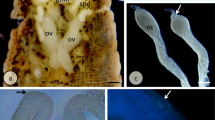Summary
Microinjected dyes were used to study transport routes between cells in the telotrophic ovarioles of the milkweed bug,Oncopeltus fasciatus. Dye movement revealed that transport through the nutritive cords is not dependent upon microtubules, and that the physiological continuity of the cords between the nurse cells and the oocyte is lost shortly after the onset of vitellogenesis. Dye-coupling of epithelial cells to the oocyte is shown to begin in a band of cells at the follicle equator. Coupling begins coincidentally with cord severance and the onset of vitellogenesis.
Similar content being viewed by others
References
Bennett CE, Stebbings H (1979) Redundant nutrative tubes in insect ovarioles: the fate of an extensive microtubule transport systems. Cell Biol Int Rep 3:577–583
Bonhag P, (1958) Ovarian structure and vitellogenesis in insects. Ann Rev Ent 3:137–160
Eschenberg KM, Dunlap HL (1966) The histology and histochemistry of oogenesis in the water strider,Gerris remigis Say. J Morphol 118:297–316
Gilula NB (1977) Gap junctions and cell communications. In: Brinkley BR, Porter KR (eds) International Cell Biology 1976–1977. Rockefeller University Press, New York, pp 61–69
Gilula NB, Epstein ML, Beers WH (1978) Cell-to-cell communication and ovulation. A study of the cumulus-oocyte complex. J Cell Biol 78:58–75
Hamon C, Folliot R (1969) Ultrastructure des cordons trophiques de l'ovarie de diverse Homopteres Auchenorynches. C R Hebd Seances Acad Sci D Sci Nat (Paris) 268:577
Huebner E (1981) Nurse cell-oocyte interaction in the telotrophic ovarioles of an insect,Rhodnius prolixus. Tissue Cell 13:105–125
Huebner E, Anderson E (1973) The effects of vinblastine sulfate on the microtubular organization of the ovary ofRhodnius prolixus. J Cell Biol 46:191–198
Huebner E, Injeyan H (1981) Follicular modulation during oocyte development in an insect — formation and modification of septate and gap junctions. Dev Biol 83:101–113
Huebner E, Woodruff RI, Telfer WH (1980) Electrophysiological and structural aspects of nurse cell-oocyte interaction in the telotrophic ovarioles ofRhodnius prolixus. Am Zool 20:867
Hymas JS, Stebbings H (1979) The mechanism of microtubule associated cytoplasmic transport. J Ultrastruct Res 68:46–57
Kelly TJ, Telfer WH (1977) Antigenic and electrophoretic varients of vitellogenin inOncopeltus blood and their control by juvenile hormone. Dev Biol 61:58–69
Kelly TJ, Telfer WH (1979) The function of the follicular epithelium in vitellogenicOncopeltus follicles. Tissue Cell 11:663–672
King RC, Büning J (1983) The origin and functioning of insect oocytes and nurse cells. In: Kerkut GA, Gilbert LI (eds) Comprehensive insect physiology, biochemistry and pharmacology, vol 1. Embryogenesis and reproduction. Pergamon Press, Oxford, pp 13.1–13.134
Lutz DA, Huebner E (1981) Development of nurse cell-oocyte interaction in the insect telotrophic ovary (Rhodnius prolixus). Tissue Cell 13:321–335
MacGregor HC, Stebbings H (1970) A massive system of microtubules associated with cytoplasmic movement in telotrophic ovaries. J Cell Sci 6:431–449
Schreiner B (1971) Vitellogenesis in the milkweed bug,Oncopeltus faciatus, Dallas (Hempitera). A light and electron microscope investigation. J Morphol 151:35–80
Stewart WW (1978) Functional connections between cells as revealed by dye-coupling with a highly fluorescent naphthalimide tracer. Cell 14:741–759
Telfer WH (1961) The route of entry and localization of blood protein in the oocytes of Saturnid moths. J Biophyus Biochem Cytol 9:747–759
Telfer WH (1965) The mechanism and control of yolk formation. Ann Rev Ent 10:171–184
Telfer WH, Woodruff RI, Huebner E (1981) Electrical polarity and cellular differentiation in meroistic ovaries. Am Zool 21:675–686
Wollberg Z, Cohen E, Kalina M (1979) Electrical properties of developing oocytes of the migratory locust,Locusta migratoria. J Cell Physiol 88:145–158
Woodruff RI (1979) Electrotonic junctions inCecropia moth ovaries. Dev Biol 69:281–295
Woodruff RI, Telfer WH (1973) Polarized intercellular bridges in ovarian follicles of theCecropia moth. J Cell Biol 58:172–188
Woodruff RI, Telfer WH (1980) Electrophoresis of proteins in intercellular bridges. Nature 286:84–86
Author information
Authors and Affiliations
Rights and permissions
About this article
Cite this article
Woodruff, R.I., Anderson, K.L. Nutritive cord connection and dye-coupling of the follicular epithelium to the growing oocytes in the telotrophic ovarioles inOncopeltus fasciatus, the milkweed bug. Wilhelm Roux' Archiv 193, 158–163 (1984). https://doi.org/10.1007/BF00848891
Received:
Accepted:
Issue Date:
DOI: https://doi.org/10.1007/BF00848891




